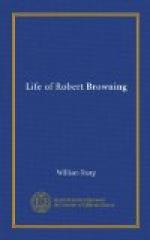his mother, 20, 23;
his uncle, Reuben Browning, 20;
the Camberwell home, 23;
his childhood, 22;
early poems, 25;
translation of the odes of Horace, 26;
goes to school at Peckham, 27;
his holiday afternoons, 27;
“Death of Harold,” 29;
criticisms of Miss Flower and Mr. Fox, 30;
he reads Shelley’s and Keats’s poems, 30, 31;
he has a tutor, 33;
attends Gower Street University College, 34;
he decides to be a poet, 35;
writes “Pauline,” 1832, 36;
it is published in 1833, 39;
“Pauline,” 39-49;
criticisms thereon, 49;
Rossetti and “Pauline,” studies at British Museum, 52, 53;
travels in 1833 to Russia, 57;
to Italy, 58;
return to Camberwell, 1834, 58, and begins “Paracelsus,” sonnet
signed “Z,” 1834, 60;
love for Venice, 62;
“Paracelsus,” 59, 62;
criticisms thereon, 71, 73;
he meets Macready, 73;
“Narses,” 76;
he meets Talfourd, Wordsworth, Landor, 77;
“Strafford,” 79;
his dramas, 85;
his love of the country, 95;
“Pippa Passes,” 96, 98;
“Sordello,” 105;
origin of “The Ring and the Book,” 1865;
“The Ring and the Book,” 113-119;
“The Inn Album,” 127;
“Men and Women,” 128;
proposed “Transcripts from Life,” 129;
“Flower o’ the Vine,” 131;
correspondence between him and Miss Barrett, 136;
meeting in 1846, 138;
engagement, 140;
marriage, 12th September 1846, 145;
sojourn in Pisa, 146;
they go to Florence, 148;
to Ancona, via Ravenna, 150;
“The Guardian Angel,” 150;
Casa Guidi, 152;
birth of son, March 9th, 1849, 157;
they go to Vallombrosa and Bagni di Lucca for the autumn, and winter
at Casa Guidi, 156;
spring of 1850 in Rome, 159;
“Two in the Campagna,” 156;
1851, they visit England;
description of Browning, 161;
winter 1851-2 in Paris with Robert Browning, senior, 162;
Browning writes Prefatory Essay to Moxon’s edition of Shelley’s
Letters, 163;
midsummer, Baths of Lucca, 165;
in Florence, 166;
“In a Balcony,” 166;
winter in Rome, 1853-4, 166;
the work written there, 167;
“Ben Karshook’s Wisdom,” 167;
“Men and Women” published, 168;
Kenyon’s death, and legacies to the Brownings, 170;
poems written between 1855-64, 169;
July 1858, Brownings go to Normandy, 173;
“Legend of Pornic,” “Gold Hair,” 173;
autumn of 1859 in Sienna; winter 1860-61 in Rome, 173;
death of Mrs. Browning, June 1861, 175;
“Prospice,” 176;
1866, Browning loses his father;
Miss Sarianna resides with Browning, 177;
his ways of life, 177;
first collected edition of his works, 1868, 178;
first part of “The Ring and the Book” published, 178;
“Herve Riel,” 179;
Tauchnitz edition, 1872, 179;
“Bishop Blougram,” 179;
his uncle, Reuben Browning, 20;
the Camberwell home, 23;
his childhood, 22;
early poems, 25;
translation of the odes of Horace, 26;
goes to school at Peckham, 27;
his holiday afternoons, 27;
“Death of Harold,” 29;
criticisms of Miss Flower and Mr. Fox, 30;
he reads Shelley’s and Keats’s poems, 30, 31;
he has a tutor, 33;
attends Gower Street University College, 34;
he decides to be a poet, 35;
writes “Pauline,” 1832, 36;
it is published in 1833, 39;
“Pauline,” 39-49;
criticisms thereon, 49;
Rossetti and “Pauline,” studies at British Museum, 52, 53;
travels in 1833 to Russia, 57;
to Italy, 58;
return to Camberwell, 1834, 58, and begins “Paracelsus,” sonnet
signed “Z,” 1834, 60;
love for Venice, 62;
“Paracelsus,” 59, 62;
criticisms thereon, 71, 73;
he meets Macready, 73;
“Narses,” 76;
he meets Talfourd, Wordsworth, Landor, 77;
“Strafford,” 79;
his dramas, 85;
his love of the country, 95;
“Pippa Passes,” 96, 98;
“Sordello,” 105;
origin of “The Ring and the Book,” 1865;
“The Ring and the Book,” 113-119;
“The Inn Album,” 127;
“Men and Women,” 128;
proposed “Transcripts from Life,” 129;
“Flower o’ the Vine,” 131;
correspondence between him and Miss Barrett, 136;
meeting in 1846, 138;
engagement, 140;
marriage, 12th September 1846, 145;
sojourn in Pisa, 146;
they go to Florence, 148;
to Ancona, via Ravenna, 150;
“The Guardian Angel,” 150;
Casa Guidi, 152;
birth of son, March 9th, 1849, 157;
they go to Vallombrosa and Bagni di Lucca for the autumn, and winter
at Casa Guidi, 156;
spring of 1850 in Rome, 159;
“Two in the Campagna,” 156;
1851, they visit England;
description of Browning, 161;
winter 1851-2 in Paris with Robert Browning, senior, 162;
Browning writes Prefatory Essay to Moxon’s edition of Shelley’s
Letters, 163;
midsummer, Baths of Lucca, 165;
in Florence, 166;
“In a Balcony,” 166;
winter in Rome, 1853-4, 166;
the work written there, 167;
“Ben Karshook’s Wisdom,” 167;
“Men and Women” published, 168;
Kenyon’s death, and legacies to the Brownings, 170;
poems written between 1855-64, 169;
July 1858, Brownings go to Normandy, 173;
“Legend of Pornic,” “Gold Hair,” 173;
autumn of 1859 in Sienna; winter 1860-61 in Rome, 173;
death of Mrs. Browning, June 1861, 175;
“Prospice,” 176;
1866, Browning loses his father;
Miss Sarianna resides with Browning, 177;
his ways of life, 177;
first collected edition of his works, 1868, 178;
first part of “The Ring and the Book” published, 178;
“Herve Riel,” 179;
Tauchnitz edition, 1872, 179;
“Bishop Blougram,” 179;




